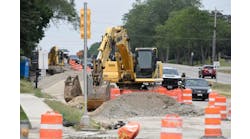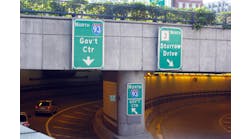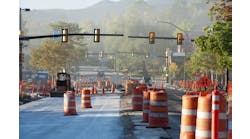While most of Florida’s cities are a mash-up of suburbs and exurbs, and are suffering economically, Gainesville has a planned, small-town feel to it and is experiencing a revival.
Part of its design and revitalization is due to the influence of its urban core and economic engine, the University of Florida, which was built in 1905, boasts 59,000 students and has no less than 33 of its buildings on the U.S. National Register of Historic Places.
Like many small American towns, Gainesville has a major north-south highway running through it, U.S. 441 (I-75 passes the city just to the west). The highway, also known in Gainesville as SW 13th Street, runs through the university and its adjacent urban neighborhoods, which offer a dramatic contrast to the mixture of strip-center sprawl, retirement communities and farmland found along the highway’s path throughout the state.
Recently, city planners have taken steps to create a greater visual congruity between the retrogressive four-lane highway and its urban surroundings. They want the highway to shed its overalls and almanac in favor of halter tops and Hemingway as it passes by the university’s gates. To better align SW 13th Street with its surroundings, the Gainesville Community Redevelopment Agency has planned a three-phase public-private redevelopment project that will create a more pedestrian urban setting for the thoroughfare that will complement a similar city project for a major artery intersecting it on the southwest corner of the campus.
Diane Bennett, ME, EI, an engineer for the Gainesville Community Redevelopment Agency, said the enhanced overpass and the new streetscape is part of a plan to encourage more alternative transportation within the city.
“We wanted to expand the pedestrian-friendly footprint surrounding the university, while encouraging more multimodal transportation.”
The centerpiece to the project will be the conversion of a former railroad bridge spanning SW 13th Street into a pedestrian overpass to create a signature gateway to the university and its surrounding neighborhoods of College Park and University Heights, where many students live. The railway bridge now serves as part of a countywide rail trail, which when finished will link together the university, Shands Medical Center, a new biotech research park, neighborhoods, a new community park and downtown, as well as be a symbol to the history and current progressiveness of the city of Gainesville.
According to the pedestrian bridge’s redesigner, Ron Sill, RLA, AP, of Reynolds, Smith and Hills Inc., the overpass, which is scheduled for completion in the summer of 2012, will be context sensitive.
“The city was very interested in reflecting the character of Gainesville with its gateway,” said Sill. “So we sought to reflect those elements in the bridge’s design.”
Sill said the design pays homage to the city’s beginnings as the central axis of important rail corridors that crossed the state during its early development (the Cross Florida Railroad and Atlantic Seaboard).
“These railroads contributed greatly to Gainesville’s growth (and Florida’s growth) during the late 1800s and early 1900s,” he said. “Also reflected in the design is the city’s innovative research in science and biotechnology being conducted by Shands Hospital and the University of Florida. These elements can be seen in the overpass—a railroad track that has been twisted into a double helix (DNA) shape and is arched. The materials will be a mix of new and old, weathering steel and new aluminum.”
A signature look
Sill said designers and city planners seek to make every project sustainable in some way, and the pedestrian walkway is no exception. He said a rain garden fashioned on the slopes leading up to the bridge has been created to treat storm water.
“In most cases treatment of storm water is hidden, but we wanted to make it visible with the terraced rain garden,” said Sill.
Bennett said that the SW 13th Street streetscape will include reconstructed clay-brick sidewalks, renaissance-style lighting, tree wells and enhanced medians with drought-tolerant/native landscaping and art features that coordinate with the pedestrian overpass design.
“We will also have a Regional Transit Authority [RTA] bus stop installed near the overpass since all of their buses have bike racks, thus creating a convenience to those biking the trail.”
She said the three-phase project will run north from SW 16th Avenue to NW 7th Avenue for a distance of 1.5 miles, which will include the southeastern-eastern boundary of the university and Shands Hospital.
“The artwork and sculptures on the median will echo the history-innovation theme of the pedestrian bridge,” she said. “We want the street to become the city’s signature corridor.”
According to Bennett, the SW 13th Street redevelopment will tie into another roadway project undertaken jointly by the University of Florida and the city’s public works department. That project will divert traffic from one of the city’s major arteries feeding into SW 13th Street from the west, Archer Road, to an alternate route, SW 16th Avenue, in order to create a more pedestrian-friendly thoroughfare.
Don Hambidge, assistant public works director for the city of Gainesville, said the intent of the Archer Road project is to reduce and slow traffic as it feeds into SW 13th Street.
“As the university has expanded, Archer Road near SW 13th Street has become more like a campus road,” he commented. “Because of the proximity of Shands Hospital, VA hospital and veterinary school, there are lots of pedestrians crossing that street.”
He said a university study conducted by Kimley-Horn Associates Inc. determined that most of the traffic was campus- or hospital-related, adding that there is very little vehicular flow-through to SW 13th Street.
One of the same
Although the state did not want to transfer the state road designation from Archer Road to SW 16th Avenue, Hambidge said the university was able to annex the road by obtaining the monies through the city while the Florida Department of Transportation (FDOT) was willing to make the necessary changes to SW 16th Avenue in order to transition it to the major east-west thoroughfare. He said plans call for the elimination of on-street parking on SW 16th Avenue to make way for bike lanes with a 4½-ft buffer.
“That will allow us to get the full capacity of the four lanes and increase traffic flow,” said Hambidge.
He said that the streetscape design of Archer Road will be similar to what is planned for SW 13th Street, with benches, bike lanes, brick sidewalks, street lamps and upgraded accessible ramps.
“We will have more crosswalks, reduce the speed limit from a 35-mph to 20-mph limit and narrow the avenue,” Hambidge said.
As an additional traffic-calming device, he said the Archer Road slip ramp onto SW 13th Street would be removed, requiring traffic to slow and stop at the intersection in order to turn north or south onto SW 13th Street. Hambidge expects the Archer Road redevelopment will be completed in conjunction with the first phase of the SW 13th Street streetscape and be a project of which the state, university and city will be proud.
Trail mix
While the Archer Road redevelopment is expected to be completed at the end of 2011 to coincide with the first phase of the SW 13th Street project, Bennett said the second and third phase of the SW 13th Street project and the reconstruction of the Depot Avenue Trail are expected to be done by 2014.
She said that in addition to being the signature gateway to the city, the pedestrian bridge creates an icon to Gainesville’s heritage and future along the Depot Avenue Rail Trail, which will be part of a countywide trail system. She said that the redevelopment of the Depot Avenue Rail Trail was a priority.
“One of the major components of the redevelopment project was the reconstruction of the Depot Avenue Rail Trail to provide connectivity between the university and downtown.
“Through landscaping elements, iconography and multimodal transportation, we wanted to reinforce the old/new theme of that connection, particularly since the trail will run adjacent to the new biotech research park, known as Innovation Square.”
Bennett said the trail will be widened to 10 ft and will include decorative trail lighting and drought-tolerant landscaping to coordinate with SW 13th Street, adding that trail markers also will be installed as well as way-finding signage to signal users that they are on a system of connected rail trails, whose nexus will be a brownfield development called Depot Park, scheduled to be completed by 2014.
“Our goal is for all the trails to connect in order to provide fully linked multimodal alternative transportation throughout the city,” she said.


